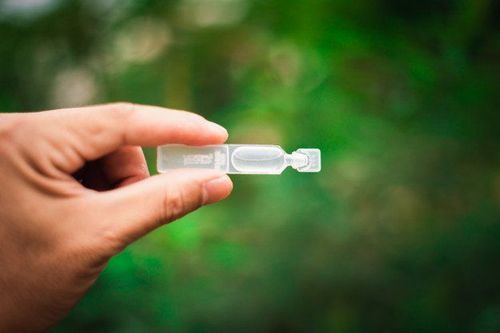This is an automatically translated article.
Corticosteroids are a group of drugs that are used very commonly with many different routes of administration, including eye drops such as the product Flarex (the active ingredient Fluorometholone). What are the side effects of Flarex?
1. What is Flarex eye drops?
Flarex eye drops 5ml is a product of the Alcon manufacturing company (Belgium) with the main ingredient being the active ingredient Fluorometholone acetate 1mg. This is a sterile eye drop suspension.
In addition, the composition of Flarex eye drops also includes a number of excipients such as Benzalkonium chloride 0.01%, Sodium dihydrophosphate monohydrate, Sodium chloride, Disodium edetat, Hydroxyethylcellulose, Tyloxapol, Hydrochloric acid, Na hydroxide (for pH adjustment) and pure water.
2. Uses of the drug Flarex
Flarex eye drops are indicated for the treatment of steroid-responsive non-infectious inflammation of the ocular parts such as eyelids, conjunctiva, cornea and anterior portion of the eyeball.Pharmacodynamic characteristics of eye drops Flarex:
Anti-inflammatory corticosteroids used in ophthalmology. The anti-inflammatory effects of Flarex (or specifically Corticosteroids) through the mechanism of preventing the adhesion of particles to vascular plaque cells, cyclooxygenase T or II and the effect of cytokines; Therefore, Flarex eye drops have the effect of reducing the production of inflammatory mediators and inhibiting the adhesion of leukocytes to the endothelial membranes of blood vessels, thereby preventing the infiltration of inflammatory tissues in the eye; The active ingredient Fluorometholone in Flarex eye drops is a synthetic steroid with potent anti-inflammatory properties. Although corticosteroids may increase intraocular pressure in susceptible individuals, Fluorometholone 0.25% in Flarex has been shown to have a significantly less risk of increased intraocular pressure than Dexamethasone sodium phosphate 0.1% in steroid sensitive cases. Pharmacokinetic characteristics of eye drops Flarex:
Studies on rabbits and humans show that after using Flarex eye drops, the active ingredient Fluorometholone will be well absorbed and distributed into the cornea and aqueous humor; As with other eye drops, systemic absorption of Flarex is expected to produce only a low plasma concentration of Fluorometholone.
3. Dosage of Flarex . eye drops
Flarex is a product for eye drops only. Before use, the patient should shake the vial well. At the same time, to avoid contamination with Flarex eye drops and eye drops suspension, patients should be careful not to let the dropper come into direct contact with the eyelids, the area around the eyes or any other object.
Dosage of Flarex eye drops is as follows:
Adults: Put 1 or 2 drops of Flarex suspension into the conjunctival sac on the side of the eye to be treated, 4 times a day. Especially for the first 48 hours, the patient can use 2 drops every 2 hours. Patients should contact a doctor if the disease does not improve after 2 weeks of using Flarex eye drops, and note that treatment should not be stopped too soon; Children: Flarex eye drops are not indicated for children because safety and efficacy have not been established; Elderly: No special note. However, the maximum duration of use of Flarex eye drops in glaucoma patients is 2 weeks, except in cases of necessity at the request of a doctor. If you miss a dose of Flarex eye drops according to the daily schedule, the patient should drop the drops as soon as possible. However, when it is almost time for your next dose, skip the missed dose and continue with your regular eye drops.
4. Flarex eye drops side effects
Adverse reactions to Flarex eye drops were reported in 3 of the 7,276 patients evaluated before and after the time of acceptance (0.04%). In which, glaucoma was the most common with 2 patients (accounting for 0.03%) and the remaining 1 patient had severe symptoms of allergic conjunctivitis.
Some common side effects of Flarex:
Glaucoma or glaucoma can occur several weeks after prolonged use of Flarex eye drops, therefore it is necessary to monitor intraocular pressure periodically during treatment; Corneal infection with Herpes, fungi or Pseudomonas aeruginosa: Flarex eye drops have the potential to lead to this effect and should be treated appropriately if present; There is a risk of corneal perforation if Flarex eye drops are used in patients with herpes infection, ulceration or trauma to the cornea...; Posterior subcapsular cataract: Long-term use of Flarex eye drops may lead to this undesirable reaction. Some other side effects of Flarex eye drops, if they occur, require appropriate intervention (such as discontinuation):
Allergy or Hypersensitivity; Blepharitis, eyelid skin, or rash; Conjunctival irritation or congestion; Suppression of the pituitary-adrenal hormone axis; Slow wound healing;
5. Some notes when using Flarex eye drops
Long-term use of corticosteroid eye drops (such as Flarex eye drops) in patients may cause increased intraocular pressure and/or glaucoma, leading to optic nerve damage, decreased visual acuity and visual field loss, and formation of cataracts. posterior subcapsular sperm. Therefore, cases of prolonged use of Flarex eye drops should be checked periodically; The risk of Corticosteroid-induced glaucoma may be higher or earlier in children than in adults, so Flarex is not approved for use in children; Glaucoma and/or cataracts caused by Flarex eye drops are more likely to occur in high-risk patients, such as those with diabetes; Flarex eye drops can weaken the immune system, increase the risk of infections, fungal or viral infections, and the drug can mask the clinical signs of infections; Patients with persistent corneal ulcers who have previously or are using Flarex eye drops or a similar product should consider the possibility of a fungal infection, and if this occurs, discontinue corticosteroid eye drops immediately; Use of corticosteroid eye drops may delay corneal wound healing, an effect that also occurs with non-steroidal anti-inflammatory drugs (NSAIDs); Diseases that thin the cornea or sclera have a high risk of perforation following topical corticosteroids such as Flarex eye drops; It is not recommended to wear contact lenses during the treatment of ocular inflammation. Also, Flarex eye drops contain benzalkonium chloride, a substance that can irritate and discolor soft contact lenses. People who need to wear contact lenses remove their lenses before using Flarex eye drops and wait at least 15 minutes before putting them back on.6. Contraindications of Flarex eye drops
People with a history of hypersensitivity to Fluorometholone or any component of Flarex; Acute bacterial eye infection has not been thoroughly treated; Herpes keratitis; Cowpox (vaccinia), chickenpox and other viral diseases of the cornea or conjunctiva; Fungal infections of eye structures; Lazy eye.
7. Some Precautions When Using Flarex Eye Drops
Use of high doses or prolonged use of Flarex eye drops increases the risk of ocular complications and systemic ADRs. Therefore, if the therapeutic effect does not respond within a reasonable time, the patient should stop using Flarex eye drops and replace with another method; The use of Flarex eye drops can reduce urinary cortisol excretion and decrease plasma cortisol concentrations; Long-term use of Flarex eye drops may develop glaucoma or glaucoma with optic nerve damage, vision loss, posterior subcapsular cataract formation; Corticosteroids such as Flarex can obscure an infection or even worsen an existing infection. Therefore, patients need to be treated with appropriate antibiotics to prevent superinfection; Use of Flarex eye drops during pregnancy: Safety has not been established. Therefore, prolonged or high frequency use of Flarex eye drops should be limited to female patients who are pregnant or planning to become pregnant; Breastfeeding mothers should use caution when using Flarex eye drops; Drug Interactions: People with indications to use other eye drops should wait at least 15 minutes between drops. Flarex drug interactions have not yet been studied.
Please dial HOTLINE for more information or register for an appointment HERE. Download MyVinmec app to make appointments faster and to manage your bookings easily.













